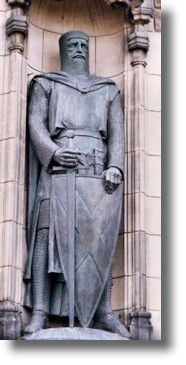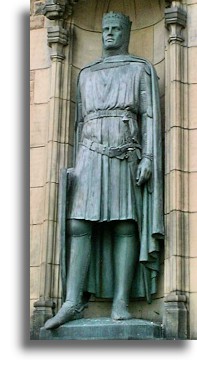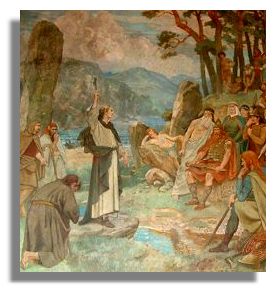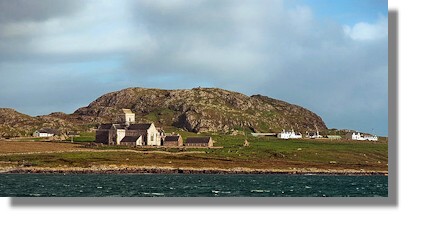

Scots History to 1400
By Michael Lynch
This is a section from the book "Scotland: a New History" by Michael Lynch which covers Scottish history from the earliest times to the present. There is an Index page of all the sections of the book up to the end of the 14th century which have been added to Rampant Scotland. The pages were previously part of the "Scottish Radiance" Web site.
Apostles of the Scots, Picts and Britons

The Search for Scotland's History is almost indistinguishable from the quest for Scotland's faith. Yet both are often obscured by wishful thinking, not only of modern-day seekers after their spiritual roots, but also of medieval chroniclers and later Protestant historians. Turn to the modern Greater Glasgow telephone directory and you will find there one of the most puzzling paradoxes of Scottish history. In a country which for the last 400 years has been riven by religious sectarianism, both the Roman Catholic faith and most shades of the reformed tradition share considerable numbers of churches dedicated to Columba or Colum Colum (dove of the church). With the possible exception of Queen Margaret, Scotland's only royal saint, no other figure in Scotland's religious past commands such widespread ecumenical agreement. There are many ironies about this, not least that almost invariably it is the Protestant churches which tend to prefer the Latin form, Columba, or that it was the Roman Catholic Church in the west of Scotland, desperately trying to cope with a flood of often unchurched Irish in the nineteenth century, which was prone to see itself as a new Irish missionary church, distinctly different from the Catholic Church in the rest of Scotland, resulting in a much higher proportion of its parish churches dedicated to Colum Cille than elsewhere. The real historical figures of Ninian, Columba, Kentigern and other 'apostles' of early Scotland need to be disentangled from their various cults, of both the Dark Ages and the medieval period. The myth of the Culdees as defenders of the Celtic Church against Roman influences, Presbyterians some hundreds of years before their time, was first invented, as has been so much else in Scottish history, by George Buchanan, Moderator of the General Assembly of the Protestant Church shortly after the Reformation of 1560 and author of a history of Scotland first published in 1582 which repeated and embellished the story of the legendary kings of Scotland stretching some eight centuries into pre-history.
 Amidst the misunderstandings and half-truths, there remains in the notion of Iona as the spiritual home of Scottish Christianity an important truth. It is likely that that was its status from the seventh century until at least the tenth, although the cult of Iona as a holy island of kings was embellished by later chroniclers and compilers of king-lists. Most, though perhaps not all of the mac Alpin kings were probably buried there up to and including Donald II Ban, who died in 900. Its position thereafter was increasingly ambiguous. Constantine 11(900-43) chose to retire as a monk to St Andrews and was buried there in 952. Iona retained its status, but had already begun to lose its influence, its role perhaps not unlike that of Geneva, an honoured grandparent of Protestant Scotland after the first flush of the generations of John Knox and Andrew Melville was past. Kings of Scots, such as Malcolm (d.954) and Indulf (d.962), were buried there again in the second half of the tenth century and emblems of Columba served as bringers of victory in that century as surely as they had in his own lifetime, but by then the real centre of ecclesiastical power has shifted eastwards, to Dunkeld and St Andrews. The last King of Scots to be buried on Iona was Donald III Ban (1093 -7). The graphic on the left of Iona and the Abbey from the sea is by Phillip Capper via Wikimedia.
Amidst the misunderstandings and half-truths, there remains in the notion of Iona as the spiritual home of Scottish Christianity an important truth. It is likely that that was its status from the seventh century until at least the tenth, although the cult of Iona as a holy island of kings was embellished by later chroniclers and compilers of king-lists. Most, though perhaps not all of the mac Alpin kings were probably buried there up to and including Donald II Ban, who died in 900. Its position thereafter was increasingly ambiguous. Constantine 11(900-43) chose to retire as a monk to St Andrews and was buried there in 952. Iona retained its status, but had already begun to lose its influence, its role perhaps not unlike that of Geneva, an honoured grandparent of Protestant Scotland after the first flush of the generations of John Knox and Andrew Melville was past. Kings of Scots, such as Malcolm (d.954) and Indulf (d.962), were buried there again in the second half of the tenth century and emblems of Columba served as bringers of victory in that century as surely as they had in his own lifetime, but by then the real centre of ecclesiastical power has shifted eastwards, to Dunkeld and St Andrews. The last King of Scots to be buried on Iona was Donald III Ban (1093 -7). The graphic on the left of Iona and the Abbey from the sea is by Phillip Capper via Wikimedia.


Amidst the misunderstandings and half-truths, there remains in the notion of Iona as the spiritual home of Scottish Christianity an important truth. It is likely that that was its status from the seventh century until at least the tenth, although the cult of Iona as a holy island of kings was embellished by later chroniclers and compilers of king-lists. Most, though perhaps not all of the mac Alpin kings were probably buried there up to and including Donald II Ban, who died in 900. Its position thereafter was increasingly ambiguous. Constantine 11(900-43) chose to retire as a monk to St Andrews and was buried there in 952. Iona retained its status, but had already begun to lose its influence, its role perhaps not unlike that of Geneva, an honoured grandparent of Protestant Scotland after the first flush of the generations of John Knox and Andrew Melville was past. Kings of Scots, such as Malcolm (d.954) and Indulf (d.962), were buried there again in the second half of the tenth century and emblems of Columba served as bringers of victory in that century as surely as they had in his own lifetime, but by then the real centre of ecclesiastical power has shifted eastwards, to Dunkeld and St Andrews. The last King of Scots to be buried on Iona was Donald III Ban (1093 -7). The graphic on the left of Iona and the Abbey from the sea is by Phillip Capper via Wikimedia.




